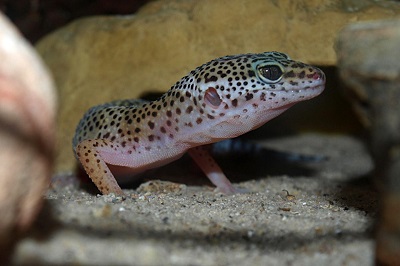Internally coupled ears enable directional hearing in animals.
Humans use the time delay between the arrival of a sound wave at each ear to discern the direction of the source. In frogs, lizards and birds the distance between the ears is too small. However, they have a cavity connecting the eardrums, in which internal and external sound waves are superimposed. Using a universal mathematical model, researchers at the Technical University of Munich (TUM) have now for the first time shown how new signals are created in this "inner ear" used by animals for localizing sounds.

An air-filled cavity connects the eardrums of the two ears of this lizzard. In this "tunnel through the head" external and internal sound waves superimpose to produce signals enabling the animal to localize the direction of the sound source. Credit: Prof. Dr. Frieder Mugele, University of Twente.
Whether perceiving an encroaching predator or finding prey in the dark, precisely localizing the source of a sound is indispensable in the animal kingdom. Almost all mammals, including humans, localize sound sources horizontally via the the delay in time in which sound signals arrive at each ear. Using this time difference the brain can calculate the direction from which the sound emanated.
Frogs, many reptiles and birds do not have this option since the distance between their ears often measures merely a few centimeters. The time difference is thus so small that it cannot be processed by the brain. To make up for this disadvantage theses animals have developed a simple albeit very effective system: An air-filled cavity connects the eardrums of the two ears.
This cavity, which runs right through the head, couples the eardrums. The scientists refer to this as "internally coupled ears" or ICE. This "tunnel in the head" is clearly visible when light falls into one ear of a gecko: The light then shines out of the other ear.
Unlike humans, the animals perceive not only external signals, but also a superposition of external sound waves with those that are created internally through the coupling of the two sides. Scientists have determined in experiments that animals use the resulting signals for pinpointing sound sources. But what exactly happens in the coupled ears remained a mystery.
A model for 15,000 species
Now, scientists working led by Leo van Hemmen, Professor of Theoretical Biophysics at the Technical University of Munich (TUM) have for the first time developed an universal mathematical model that describes how sound waves propagate through the internally coupled ears and which clues for localizing sound sources are created in the process.
"Our model is applicable to all animals with this kind of hearing system, regardless that the cavities between the eardrums of the various species look very different," explains van Hemmen. "We now understand what exactly happens inside the ears of these animals and can both explain and predict the results of experiments in all sorts of animals." Over 15,000 species have internally coupled ears - that is more than half of all land-dwelling vertebrate animals.
External and internal signals in concert
Using their model, van Hemmen and his team discovered that the animals have even developed two different methods of hearing with internally coupled ears. They occur in different frequency domains and augment each other.
In sounds below the fundamental frequency of the eardrum the time difference in the superposition of the internal and external signals is amplified up to five-fold. That is sufficient to facilitate sound localization.
In higher frequencies the time difference can no longer be evaluated. Here, another property of the signal becomes relevant: The difference in the amplitude, i.e. the loudness, of the sound perceived by the ears. "The amplitude difference occurs solely through the coupling of the two ears," explains van Hemmen. "That was a surprising result."
This new insight on the mechanisms and especially the advantages of hearing with internally coupled ears is also relevant for industrial applications. It is conceivable that robots will be equipped with this kind of hearing system. "I can very well imagine applications in robotics, because this kind of amplification doesn't need energy" expresses van Hemmen. In the future van Hemmen and his team of scientists hope to refine their model in collaboration with the experimental work of colleagues.
Partner of this research were: Chair for Theoretical Biophysics (T35), Department of Physics at Technical University of Munich (Germany), Bernstein Center for Computational Neuroscience-Munich (Germany), Institute of Neuroscience and Medicine, Research Center Ju?lich (Germany), Center for Sound Communication, Syddansk Universitet (Odense, Denmark) and Kirksville College of Osteopathic Medicine, A.T. Still University (Kirksville, Missouri, USA).
Publication:
A.P. Vedurmudi, J. Goulet, J. Christensen-Dalsgaard, B.A. Young, R. Williams, and J.L. van Hemmen, How Internally Coupled Ears Generate Temporal and Amplitude Cues for Sound Localization, Physical Review Letters, 116, 028101 DOI: 10.1103/PhysRevLett.116.028101
Source: https://www.eurekalert.org/pub_releases/2016-02/tuom-att021816.php

